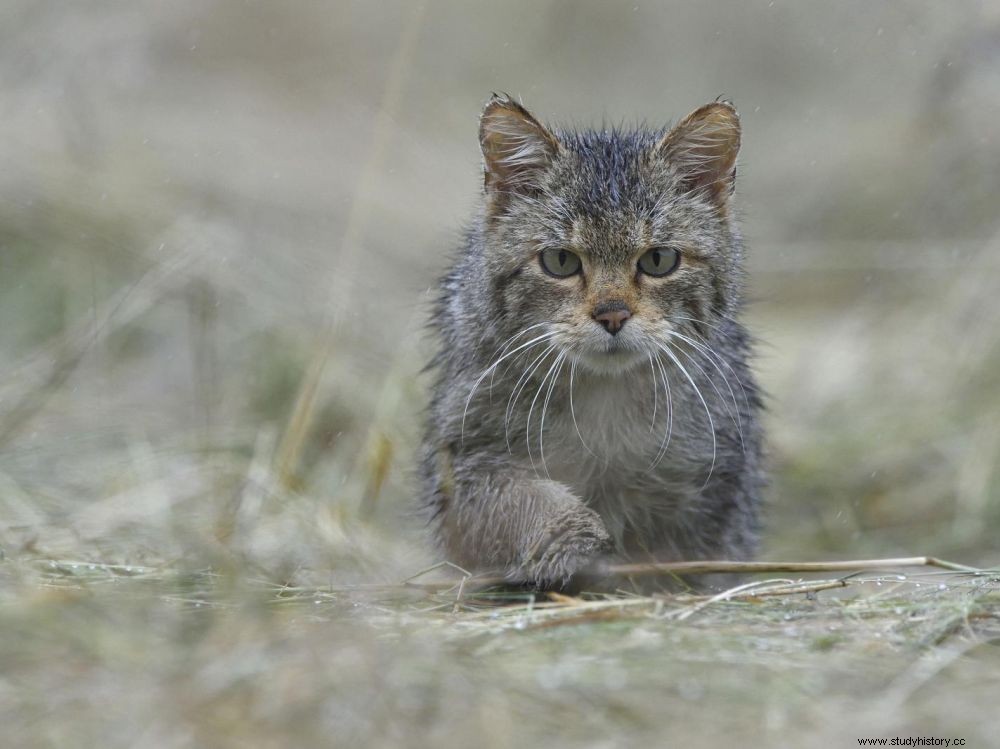We know that our current domestic cat is a distant descendant of a wild cat present in the Near East at the beginning of the Neolithic period. After following the first farmers of the Fertile Crescent to Europe, whose cereal crops attracted rodents, it nevertheless forged links with humans much later, according to a recent study.

Dated to 4,200 BC, i.e. before ancient Egypt, the oldest traces of the ancestor of the domestic cat, a wild cat from the Near East, have been discovered in Poland. The small felines would have followed the populations of farmers to Europe, cereal crops attracting rodents.
While it was thought to come from the European wildcat (Felis sylvestris sylvestris) , we recently learned that the tomcat who may be snoring on your couch right now (Felis sylvestris catus) actually descended from the African wildcat (Felis sylvestris lybica), an animal still found in North Africa and southern Asia Minor. Attracted to the first farmers of humanity by the influx of rodents that grain stocks caused, it is assumed that the small wild feline accompanied populations from the Fertile Crescent to Europe from its Neolithization, around 6,500 BC. But did he follow Man or did humans take him with them, already attached to his presence and his services?
A domestication difficult to date
If the geneticists had been able to rewrite the scenario of the diffusion of the cat, they had not until now managed to locate with certainty the moment when its domestication had really taken place. Unlike other species which have been profoundly modified by human beings, such as the dog, the domestic cat remains quite close to the wild cat from a genetic point of view, making it difficult to establish a shift in its relationship with man. But new results finally come to decide on the question:
While it was thought to come from the European wildcat (Felis sylvestris sylvestris) , we recently learned that the tomcat who may be snoring on your couch right now (Felis sylvestris catus) actually descended from the African wildcat (Felis sylvestris lybica), an animal still found in North Africa and southern Asia Minor. Attracted to the first farmers of humanity by the influx of rodents that grain stocks caused, it is assumed that the small wild feline accompanied populations from the Fertile Crescent to Europe from its Neolithization, around 6,500 BC. But did he follow Man or did humans take him with them, already attached to his presence and his services?
A domestication difficult to date
If the geneticists had been able to rewrite the scenario of the diffusion of the cat, they had not until now managed to locate with certainty the moment when its domestication had really taken place. Unlike other species which have been profoundly modified by human beings, such as the dog, the domestic cat remains quite close to the wild cat from a genetic point of view, making it difficult to establish a shift in its relationship with man. But new results finally come to settle the question:the ancestor of the European cat was not finally carried around in the luggage of Man like a vulgar indoor cat. He would rather have walked in their footsteps with dignity, of his own accord, and would have taken advantage of the proliferation of rodents near the crops for a long time before indulging in the ease of the bowl. This conclusion, which we owe to the Polish bioarchaeologist Magdalena Krajcarz, is the subject of a publication on Monday July 13, 2020 in the journal PNAS .
Magdalena Krajcarz and her colleagues analyzed stable isotopes of Late Neolithic cat bones (dated to 4,200-2,300 BC) found in Poland and providing the earliest evidence to date of cat migration from the Near East to Central Europe. In order to get an idea of the diet of these felids, they compared them to stable isotopes from 34 related animal species, including the European wildcat. "In this way, we were able to study the diet of the oldest cats from the Near East to Poland" , explained the researcher to Sciences et Avenir . "We then looked for traces of synanthropy" , a phenomenon that characterizes for an animal the fact "to live close to humans and to explore anthropogenic food resources" .
"A commensal and free relationship"
Isotope ratios of Near Eastern and wild European cats thus showed only minor differences, suggesting that the cats shared an ecological niche at the time. The team further compared the ecology of cats from the Near East with those of the first known domestic cats in Poland (dating from the Roman period):according to their observations, human agriculture had already had an impact on the isotopic signature of the rodents on which Paleolithic cats largely fed. "Although Near Eastern cats may have followed early breeders to Europe, they were opportunistic synanthropists, living in a commensal and free relationship with man. They were not yet totally dependent on him for their life. diet and shared an ecological niche with native wildcats."
The earliest documented interaction between cats and humans dates back 7,500-7,200 years (2004 article published in Science ):This is the burial of a specimen alongside a child discovered in Cyprus. If it necessarily translates a form of taming of the cat, it cannot however be enough to speak of domestication. The earliest solid evidence of domestication is found in Ancient Egypt, in the New Kingdom, around 1,500 BCE.
